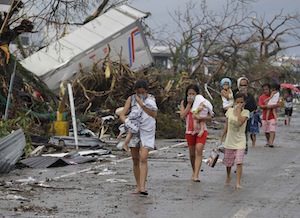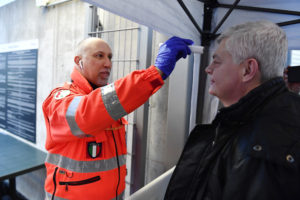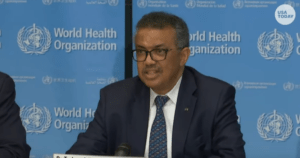Typhoon Devastates the Philippines; Death Tally Soaring
Potentially the most powerful typhoon on record, Haiyan swept across the Philippines on Friday and is heading for Vietnam, leaving a massive wake of death and destruction. But wait for the death toll -- early reports rarely bear up.
The incomprehensibly powerful typhoon Haiyan blasted across the central Philippines on Friday, leveling coastal cities with a tsunami-like storm surge, and disintegrating buildings with sustained winds nearing 200 mph with gusts up to 235 mph, according to reports.
Particularly hard hit was the coastal city of Tacloban, where as many as 220,000 people have been left homeless, and the death toll could reach 10,000. Reports say the ocean’s storm surge and winds destroyed or damaged virtually every building in the city.
Note, though, that initial death counts from such disasters rarely bear out over time. In the hours after the typhoon struck, the first death tally was four, reflecting a lack of information available to a world hungry for details. Estimates bouncing around Sunday morning will likely be just as inaccurate — either far too high or far too low.
One thing that’s clear is the region is devastated, and the loss in terms of human life and property damage will be staggeringly high. And the somewhat weakened storm is still moving, heading across the South China Sea for the northern provinces of Vietnam, where more than 600,000 people have been evacuated to what it is hoped is safer ground.
The BBC described the devastation in the Philippines in dry, but clear terms:
The BBC’s Rupert Wingfield-Hayes reports that the scene in Tacloban, the capital of Leyte province, is one of utter devastation.
Houses in Tacloban have been flattened by the massive storm surge that accompanied Typhoon Haiyan.
There’s no clean water, no electricity and very little food.
City officials said they were struggling to distribute aid and that looting was widespread.
In some areas, the dead are being buried in mass graves.
Our correspondent says hundreds of people are at the airport, itself badly damaged, trying to get on a flight out of Tacloban.
The New York Times notes that the worst-hit section of the Philippines was also struck a month ago by a magnitude 7.2 earthquake, severely straining the nation’s financial resources for providing relief and reconstruction. According to the Times:
The first and most vocal city to cry for help over the weekend was Tacloban on Leyte Island, which was also one of the first places hit by the typhoon, called Yolanda in the Philippines. In many other communities along the storm’s track, virtually all communications were cut off.
The typhoon left Tacloban in ruins, as a storm surge as high as 13 feet overwhelmed its streets, with reports from the scene saying that most of the houses had been damaged or destroyed in the city of 220,000. More than 300 bodies have already been recovered, said Tecson John S. Lim, the city administrator, adding that the toll could reach 10,000 in Tacloban alone.
A Save the Children spokeswoman who weathered the storm in Tacloban told the Times that schools and other public buildings used as shelters failed to stand up against the winds and rains.
The Guardian reports that many towns and villages, particularly those along the coast where the storm made landfall, are beyond the ready reach of rescuers and aid workers. The Guardian offers details:
One significant challenge is that no one as yet knows the precise extent and location of all the devastation. There has been understandable focus on Tacloban, the main city on Leyte island, with some estimates saying up to 10,000 people could have died here alone. However, there has been little word from other, more remote areas in the path of the storm, both on Leyte and also Samar island, to the north-east, and the northern tip of Cebu, to the west.
Bray said Oxfam already had a team elsewhere on Cebu, who had managed to make their way, with great difficulty, to the north. There, the team estimated, 98% of buildings had been damaged. They saw children holding signs, begging for good and water.
Likening the extent of destruction to the 2004 Indian Ocean tsunami, Bray said: “Getting up there was really difficult, because the roads are strewn with debris and wreckage. Getting to places for immediate response is going to be a big challenge for everyone, because of the level of destruction.”
There was more to think of beyond shelter, clean water and food, he added: “In the immediate aftermath people need these emergency requirements, but in the medium to long term people’s crops will be affected, and things like fishing equipment. Though there’s obviously a massive immediate need, there will also be other needs as well, not just today but in the months to come.”
—Posted by Scott Martelle
.
Your support matters…Independent journalism is under threat and overshadowed by heavily funded mainstream media.
You can help level the playing field. Become a member.
Your tax-deductible contribution keeps us digging beneath the headlines to give you thought-provoking, investigative reporting and analysis that unearths what's really happening- without compromise.
Give today to support our courageous, independent journalists.







You need to be a supporter to comment.
There are currently no responses to this article.
Be the first to respond.